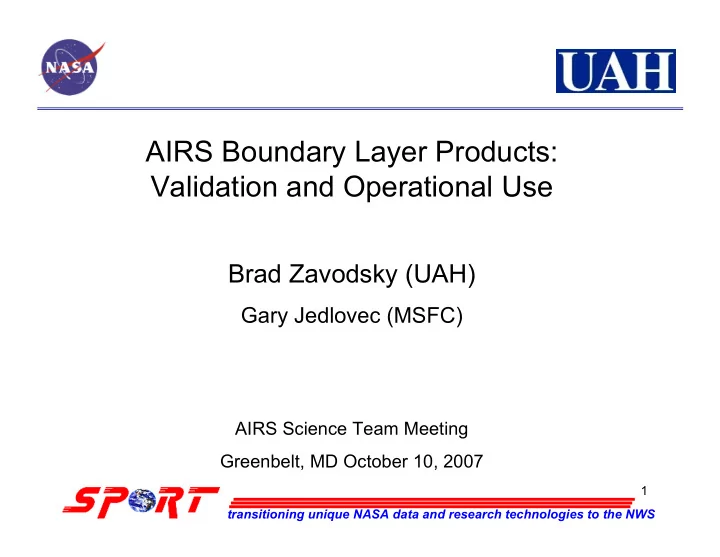

AIRS Boundary Layer Products: Validation and Operational Use Brad Zavodsky (UAH) Gary Jedlovec (MSFC) AIRS Science Team Meeting Greenbelt, MD October 10, 2007 1 transitioning unique NASA data and research technologies to the NWS
Overview Motivation: Most weather occurs in the Planetary Boundary Layer (PBL), but observations are scattered point observations like METARs, RAOBs, ground-based sensors, and buoys. AIRS could add thousands of systematic observations of the PBL to aid forecasters. ♦ Planetary Boundary Layer (PBL) Refresher/Tutorial ♦ UAH MPR and RSA Rawinsonde Validation Datasets ♦ Products for NWS WFOs ♦ Summary/Future Plans 2 transitioning unique NASA data and research technologies to the NWS
Planetary Boundary Layer (PBL) ♦ The planetary boundary layer (PBL) is the lowest 1-2 km influenced by: • friction (slows and redirects winds) • evapotranspiration (modulates moisture) • heat and energy transfer (radiation and convection; modulates temperature) ♦ Two types of PBLs: • stable (nocturnal): characterized by cool air near surface with capping inversion • unstable (afternoon): characterized by warm air near surface ♦ AIRS may aid in detection of: • destabilization in unstable PBL that can lead to convection • depth of stable PBL that can cause fog, smoke, or low clouds to linger near the surface and disrupt travel or cause serious health risks 3 transitioning unique NASA data and research technologies to the NWS
Mobile Integrated Profiling System (MIPS) • MIPS stationed at NSSTC in Huntsville MPR MIPS RSA rawinsonde • 12Z rawinsonde launched from Redstone Arsenal (approximately 10 km south of NSSTC) 4 transitioning unique NASA data and research technologies to the NWS
Microwave Profiling Radiometer (MPR) ♦ MPR is one component of MIPS instrument suite ♦ Generates temperature, dew point, and liquid water profiles at vertical resolution of 100 m below 1 km and 250 m above 1 km every minute ♦ Temperature accuracy: • 1.0 K from surface to 2 km • 1.5 - 2.0 K from 2-10 km ♦ Moisture accuracy: • 0.2 - 0.3 gm -3 from surface to 2 km • 1.0 - 1.5 gm -3 from 2-10 km 5 transitioning unique NASA data and research technologies to the NWS
NRT AIRS/MPR Website ♦ SPoRT uses UWDB profiles (currently V4; soon V5) AIRS temperature and moisture data to produce NRT comparisons between MPR and AIRS ♦ A sounding comparison is generated for the closest AIRS sounding within 75 km of the MPR location ♦ Results of these comparisons are available in NRT on SPoRT website ♦ Website provides ability to zoom to lowest 3 km of troposphere http://weather.msfc.nasa.gov/sport/mips_airs /investigations.html 6 transitioning unique NASA data and research technologies to the NWS
AIRS Products for WFO Sample AWIPS display of an AIRS product ♦ Forecasters will only use data in their native system (AWIPS) ♦ Use AIRS to fill in temporal voids in radiosonde data record ♦ Emphasis on real-time data access ♦ Possible PBL products: • PBL height • mean PBL T and q • stability parameters (LCL, mean lapse rate, etc.) ♦ Work with forecasters to assess added value of product by use of online surveys 7 transitioning unique NASA data and research technologies to the NWS
Summary/Future Work ♦ SPoRT, through its partnership with UAH has access to unique datasets in the MPR and RSA radiosondes for validating AIRS PBL capabilities ♦ AIRS derived products can be a valuable asset to address NWS forecast problems associated with the atmospheric boundary layer ♦ Finalize comprehensive plan to: • validate real-time V5 AIRS profiles in the lowest 3km using MPR and RSA radiosonde data over northern Alabama • produce unique real-time boundary layer products (e.g. PBL height, mean PBL T, q and stability) from AIRS in AWIPS format to address NWS forecast problems • look at transitioning AIRS products to operations in the NWS Southern Region (assessment of product utility for NWS) 8 transitioning unique NASA data and research technologies to the NWS
Recommend
More recommend